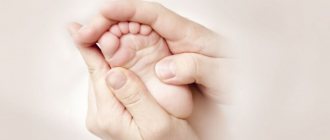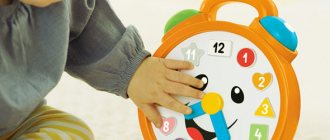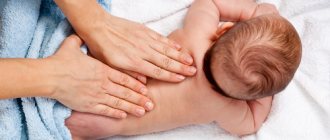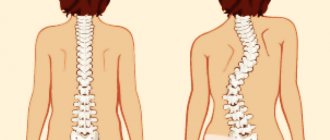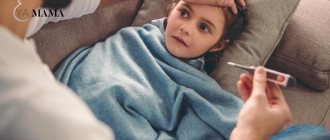Every mother can do a relaxing massage for infants with hypertension on her own. This simple procedure will help your baby calm down and sleep peacefully. Hypertonicity is too much muscle tension. Such spasms are very painful, so the child behaves restlessly. Proper massage will relieve symptoms and prevent their recurrence.
Basic recommendations
A properly performed massage will help your baby get rid of pain and relax. Follow these guidelines:
- Create a comfortable environment. Ventilate the room. Maintain the room temperature at 23 degrees. Make sure there are no drafts, strong sounds or strong odors.
- It is most effective to conduct a session in the morning before feeding. At this time, the baby’s intestines are free and the impact is much easier to bear.
- A relaxing massage for infants is best done on a wide, high table. Place a diaper on top of it.
- Before the procedure, apply massage oil or baby cream to your hands. Please remember that using products for adults is strictly prohibited.
- All actions should be as smooth and gentle as possible. Make circular movements only in a clockwise direction.
- If the baby is not yet three months old, the procedure lasts no more than five minutes. For older children, this time increases to 10 minutes.
- You cannot feed the baby immediately after the session. Wait at least 40 minutes.
Compliance with all these requirements will allow the baby to get the maximum benefit and pleasure from the massage.
Carry out all actions with clean hands. They should not be wearing rings or bracelets. Before the procedure, rub your palms together to make them warm.
Before starting a course of such sessions, consult your pediatrician.
Features of the procedure
An important feature of this massage for infants is the ability to calm the baby’s overexcited nervous system - this is very useful before bed. Unlike other techniques, this type of massage performs a number of important functions for the health and body of the baby, namely:
- strengthens the immune system;
- relieves muscle hypertonicity;
- eliminates negative emotions and calms the baby;
- improves blood circulation;
- Positively affects the baby’s nervous system;
- improves metabolism in the body;
- eliminates colic in the abdominal cavity;
- a relaxing massage is recommended for bronchitis, as it helps relax the muscles of the respiratory tract and accelerates the removal of phlegm;
- It is recommended for frequent constipation in infants, as it has a positive effect on intestinal function.
Massage technique
The technique of relaxing massage for infants with hypertension is quite simple. The main thing is to remember the basic rules:
- It is better to start the impact from the left leg. Place the baby on his back. Gently grab your foot by the ankle joint. Use your other hand to stroke your foot. Gradually work your way up your shin to your thigh. Massage the thigh and groin area for at least three minutes. After this, move on to the other leg.
- Rub all the muscles on your baby's legs. Do this with your fingertips. Perform movements first from bottom to top, and then vice versa.
- Bend and straighten your child's legs. In this case, you can lightly press them on the tummy.
- Proceed to massage your back and buttocks. Turn the baby onto his tummy. Knead and rub your skin. Make stroking movements along the entire spine from top to bottom. You can press lightly on the buttocks. Pinching movements are also acceptable. Don't overdo it and don't hurt your baby.
- Turn the baby over onto his back again and massage the breasts with light stroking movements. Using rubbing gestures, go over the entire surface from the sternum to the armpits.
- The next stage of a relaxing massage for infants with hypertension will be working on the hands. Start rubbing and stroking your left arm. Make movements from top to bottom. Massage the muscles located on the outside with light tapping. Stroke the internal muscles gently and smoothly. Repeat the same steps with the other hand.
- Bring your baby's arms together and apart. Cross them over your chest and return to the starting position. Alternately lift them up and down. At the same time, you can shake them slightly.
- The final stage of the massage should be stroking the legs, back and buttocks. This will help soothe your skin and muscles after the massage.
If such a massage does not help get rid of the symptoms of hypertonicity, you can try therapeutic exercises.
Massage sessions should become a habit. Do them every morning and your baby will always feel good.
To study the technique in detail, watch a training video about relaxing massage for infants. It will help you learn all the movements in detail.
Massage for a child is the best way to fall asleep
Massage for a child is the best way to fall asleep More news from the section:
- Psoriasis looks younger
- Scientists have discovered a new type of immunodeficiency
- Survival School: Stomach Pain
Why is a baby’s sleep restless, why does he cry? Apparently something is bothering him? The well-being of a child, like an adult, can be controlled with the help of massage. You just need to remember that the baby’s bones are fragile, there are vulnerable places - the fontanelles on the head, so massage movements should be gentle, careful, and massage in the area of the fontanelles is generally contraindicated. It is also necessary to remove rings, bracelets, watches, so as not to inadvertently scratch the skin, hands must be thoroughly washed and warmed. In case of acute febrile conditions, inflammatory processes, skin diseases or excessive agitation of the child, you should refrain from massage. Usually the child is massaged by stroking.
You should start stroking: on the hands - from the fingertips to the elbow joints and then to the armpits; on the legs - also from the tips of the fingers to the knee joints and groin area; on the back and chest - from the neck to the armpits, then to the groin areas. Superficial stroking relieves pain and promotes restful, sound sleep. Stroking is done with palms, moving them along the skin in parallel or one after the other. The massager's palms should be dry and warm. Rubbing, as we already know, is different in that with this technique the massaging hand does not slide over the skin, but moves it and the underlying tissues in different directions. Massage movements do not necessarily have to coincide with the blood flow. Rubbing enhances muscle function, improves joint mobility, and accelerates blood circulation. The duration of both stroking and rubbing is 10 minutes, with a partial massage - say, just the arms or legs - no more than 5 minutes. So far we have been talking about general massage. But acupressure is also possible - it is carried out using the same techniques, it is only necessary to thoroughly study the location and purpose of the reflexogenic zones. Perform acupressure massage with fingertips; duration for one reflex zone is 1-2 minutes. In one session, 3-4 zones are massaged. Acupressure massage can be done 2-3 times a day, it is better to precede it with a general massage. Now let's talk about some specific techniques that should be used in case of certain ailments. One of the most common causes of illness in a child is indigestion. He screams from the gases accumulated in the intestines, presses his legs to his tummy, and does not sleep. To normalize intestinal function and improve digestion, give your child acupressure to the reflexogenic zone located around the navel. Use your fingertips to gently and deeply stroke the lumbar region - there is a large reflexogenic zone responsible for the functions of the digestive organs, liver and kidneys. Rub, only very gently and carefully, with the tips of your thumb and forefinger, the reflexogenic zone in the triangle between the baby’s thumb and forefinger. This is a very important area, it has a general strengthening effect on the entire body, normalizes intestinal function, improves appetite, and relieves nervous tension. Does your child sleep restlessly at night? Try to apply shallow and deep stroking of the same reflexogenic zone - in the triangle between the child's thumb and index finger. It is good to complement it with light kneading of the earlobes - with the help of these techniques, muscle tension is relieved, the child begins to yawn, and a deep, refreshing sleep soon sets in. Difficult nasal breathing is often the cause of poor health in children, and during school years, even the cause of absent-mindedness and lag in school. If you notice that your child breathes through his mouth more readily, rush to the doctor, he will check for polyps in the nasal passages. In very young children, difficulty breathing is most often associated with swelling of the nasal mucosa. In this case, acupressure of reflexogenic zones located in the upper part of the nasolabial folds, between the inner ends of the eyebrows, and on the earlobes is effective. Massaging the earlobe is best done with the pads of the thumb and index finger; massage movements should be gentle and gentle so as not to cause swelling of the ear.
mp3dinle.ru www.qirim.info www.jurnalist.com.ua avdet.qirim.org poluostrov.qirim.org www.yanidunya.org veseloe.qirim.info www.goloskrima.com vashsudak.ru
Problems that a mother may face
During the massage, the baby experiences pain, so he may resist and show anxiety. The most common problems that arise are:
- During the procedure, the child screams loudly. This is the baby's reaction to pain. Try to make all movements smoothly. Talk to your child, sing his favorite songs. Try to distract him from unpleasant sensations.
- The baby cries after the procedure. This happens due to feeling tired, hungry, lack of oxygen or severe overexcitation. In this case, rock the baby in your arms and talk to him. If this doesn't help, give him a warm bath with a little lavender or pine needle oil. After that, feed and put him to bed.
Crying is a normal reaction of a baby to new, unusual actions. If during the procedure the child does not make any sounds, then the massage is ineffective and is carried out incorrectly.
Gymnastics for hypertension
The effect of massage can be enhanced many times over if you perform gymnastic exercises together with it. Among them, the most effective are:
- Hold your child by the armpits. Rock your baby with smooth movements. This exercise can also be done in a bath of water.
- Place your baby's tummy on an exercise ball. Hold your back and legs. Swing in different directions. Make sure that all actions are performed as smoothly as possible.
- Place the baby on his tummy. Help him crawl by moving his arms and legs.
- The baby should lie on his back. Spread your legs to the side and bring them back. The child will resist this influence, so try not to press too hard.
By adhering to the correct massage technique, you can cure a baby of hypertension. He will always remain calm and cheerful.

